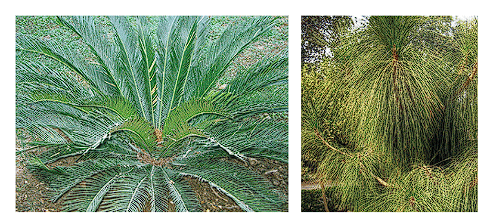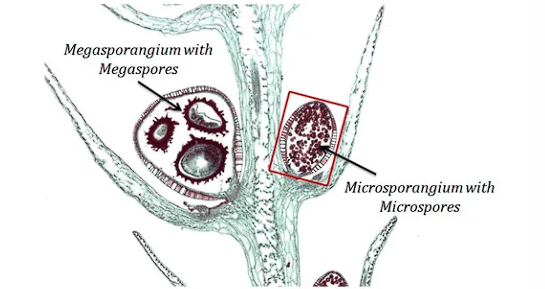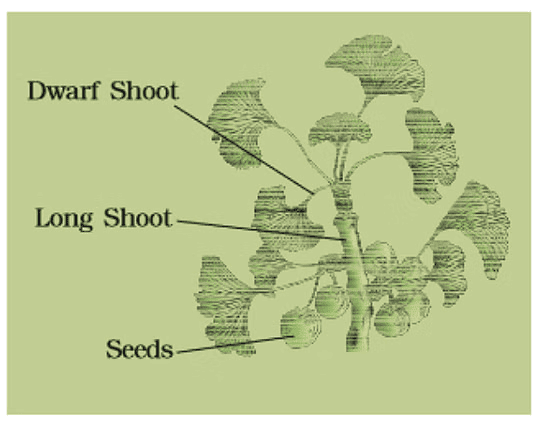Gymnosperms | Biology Class 11 - NEET PDF Download
| Table of contents |

|
| Introduction |

|
| Structures of root, stem, and leaves |

|
| Reproductive Structures |

|
| Ovule Development |

|
| Angiosperms |

|
Introduction
Gymnosperms are plants where the ovules are exposed, without being enclosed by an ovary wall, both before and after fertilization. The seeds that develop after fertilization are also naked, meaning they are not covered. These plants include medium-sized to tall trees and shrubs. For example, the giant redwood tree (Sequoia) is one of the tallest tree species among gymnosperms.

Structures of root, stem, and leaves
(a) Root Structures
- Gymnosperms typically have taproot systems.
- Some genera, like Pinus, have roots associated with fungi in a symbiotic relationship called mycorrhiza.
- In other genera, such as Cycas, specialized roots known as coralloid roots harbor nitrogen-fixing cyanobacteria.
(b) Stem Structures
- The stems of gymnosperms can be either:
- Unbranched, as seen in Cycas.
- Branched, as in species like Pinus and Cedrus.

(c) Leaf Structures
- Leaves in gymnosperms can be either simple or compound.
- In Cycas, the pinnate leaves are persistent, remaining on the plant for several years.
- Gymnosperm leaves are adapted to withstand extreme conditions of temperature, humidity, and wind.
- For instance, in conifers, the needle-like leaves have a reduced surface area, which helps minimize water loss. These leaves also feature a thick cuticle and sunken stomata, further aiding in water conservation.
Reproductive Structures
Gymnosperms are a group of plants that produce two types of spores: microspores (male) and megaspores (female). These spores are formed within specialized structures called sporangia, which are located on sporophylls (leaf-like structures). Sporophylls are arranged in a spiral pattern along an axis, forming strobili or cones, which can be either lax or compact.

Types of Strobili
- Microsporangiate (Male) Strobili: These strobili bear microsporophylls and microsporangia.
- The microspores develop into pollen grains, which represent a highly reduced male gametophyte.
- Pollen grains are formed within the microsporangia.
Macrosporangiate (Female) Strobili:
- These strobili bear megasporophylls with ovules or megasporangia.
- In some species, like Pinus, both male and female cones can be found on the same tree.
- In others, like Cycas, male cones and megasporophylls are found on different trees.
Ovule Development
The megaspore mother cell, which is derived from a cell in the nucellus, undergoes meiosis to produce four megaspores. One of these megaspores develops into a multicellular female gametophyte, which contains two or more archegonia (female sex organs). The female gametophyte is retained within the megasporangium.
Note: Unlike bryophytes and pteridophytes, gymnosperms have a different reproductive process where the male and female gametophytes do not exist independently. Instead, they are retained within the sporangia on the sporophytes.

- Pollen Grain Release: The pollen grain is released from the microsporangium.
- Pollination: The pollen grains are carried by air currents and come into contact with the openings of the ovules, which are borne on the megasporophylls.
- Pollen Tube Formation: The pollen tube, which carries the male gametes, grows towards the archegonia in the ovules.
- Fertilization: The male gametes are discharged near the mouth of the archegonia.
- Development: After fertilization, the zygote develops into an embryo, and the ovules develop into seeds.
- Seed Structure: These seeds are not covered.
Angiosperms
In angiosperms, pollen grains and ovules are developed within specialized structures called flowers. Unlike gymnosperms where the ovules are naked, angiosperms protect their seeds within fruits.
- Angiosperms are a vast group of plants found in a wide range of habitats, varying in size from the tiny Wolffia to towering trees like Eucalyptus, which can exceed 100 meters in height.
- They are a crucial source of food, fodder, fuel, medicines, and various other commercially important products.
- Angiosperms are classified into two main groups:
(i) Dicotyledons(dicots)
(ii) Monocotyledons(monocots)
|
150 videos|398 docs|136 tests
|
FAQs on Gymnosperms - Biology Class 11 - NEET
| 1. What are the main structures of roots, stems, and leaves in plants? |  |
| 2. How do reproductive structures differ between angiosperms and gymnosperms? |  |
| 3. What is the process of ovule development in plants? |  |
| 4. What are the key differences between angiosperms and gymnosperms? |  |
| 5. Why is the structure of leaves important for photosynthesis? |  |
















